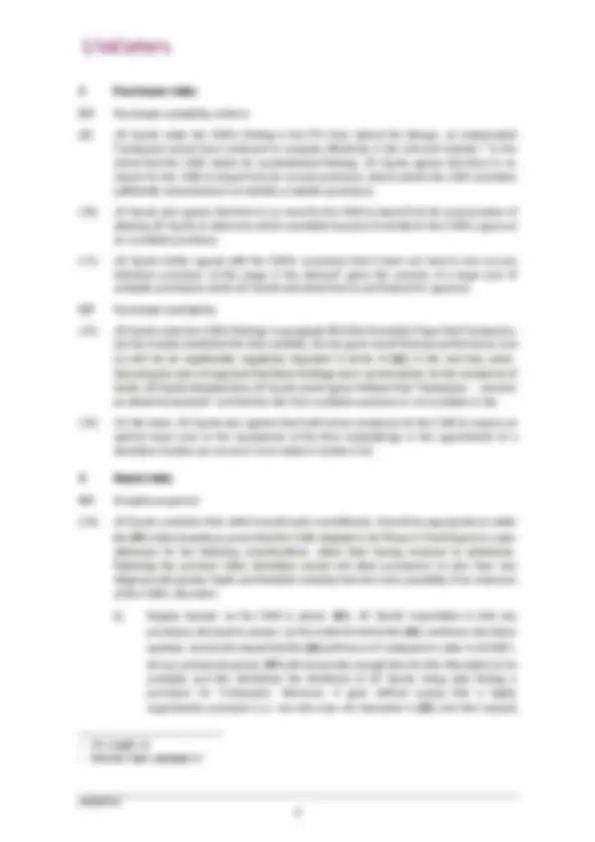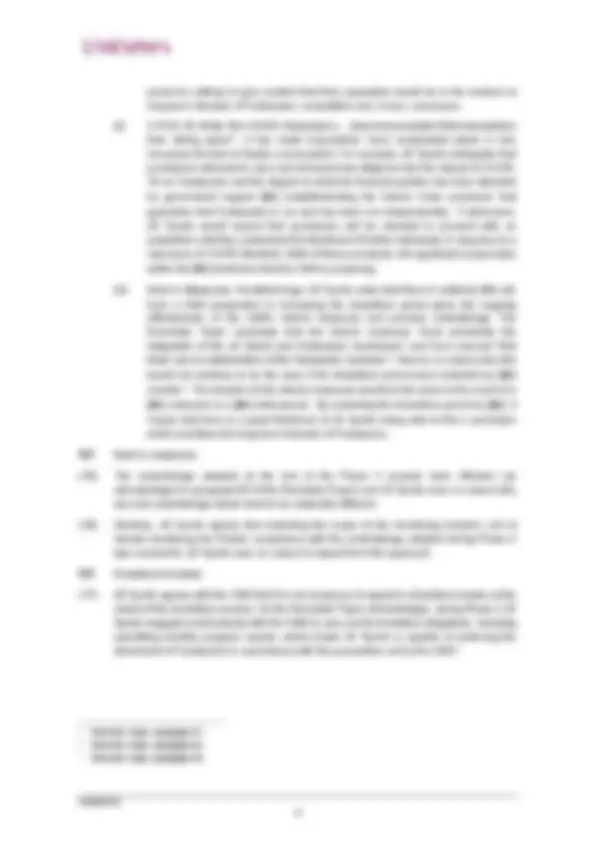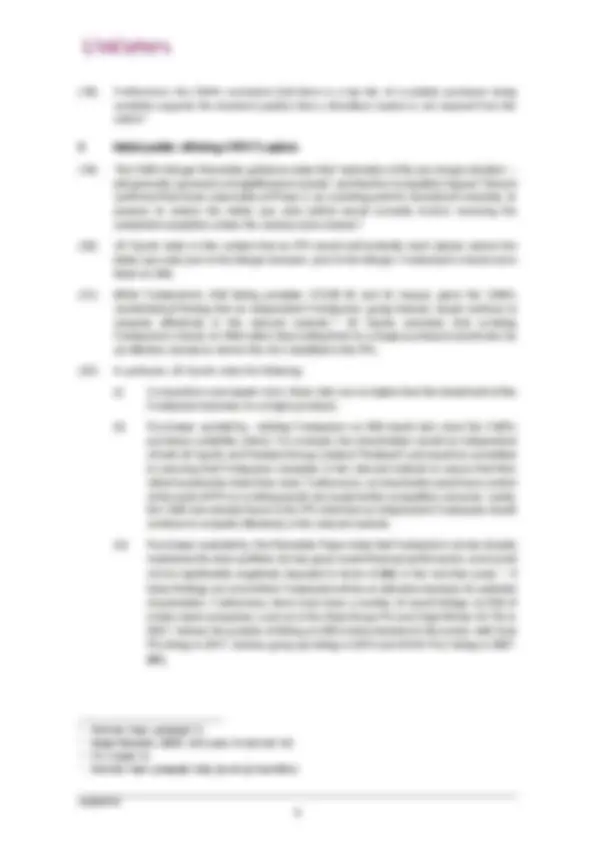





Study with the several resources on Docsity

Earn points by helping other students or get them with a premium plan


Prepare for your exams
Study with the several resources on Docsity

Earn points to download
Earn points by helping other students or get them with a premium plan
Community
Ask the community for help and clear up your study doubts
Discover the best universities in your country according to Docsity users
Free resources
Download our free guides on studying techniques, anxiety management strategies, and thesis advice from Docsity tutors
JD Sports' submission in response to the CMA's remedies paper regarding the acquisition of Footasylum, expressing disagreement with the provisional finding of a substantial lessening of competition and the proposed remedies, discussing composition risks, purchaser risks, asset risks, and potential customer benefits.
Typology: Schemes and Mind Maps
1 / 6

This page cannot be seen from the preview
Don't miss anything!




A
(1) This submission sets out the response of JD Sports Fashion plc (“ JD Sports ”) to the CMA’s remedies paper published on 2 September 2021 (the “ Remedies Paper ”) in relation to the completed acquisition by JD Sports of Footasylum Limited (“ Footasylum ” and together with JD Sports, the “ Parties ”) (the “ Merger ”).
(2) JD Sports notes that the Remedies Paper has, as its necessary premise, the provisional finding of a substantial lessening of competition (“ SLC ”) as identified in the CMA’s Provisional Findings report (“ PFs ”).
(3) JD Sports disagrees with this premise because there are fundamental flaws in the PFs that, once corrected, should lead the CMA to conclude in its Final Report that the Merger does not result in an SLC. For this reason, as JD Sports considers the SLC finding is unjustified, the same applies to the CMA’s proposal in the Remedies Paper, as any such remedy will unnecessarily deprive customers of the benefits arising from the Merger.
(4) JD Sports’ comments on this Remedies Paper are without prejudice to these points which, as to the SLC analysis, will be addressed in the Response to the PFs and not repeated below.
(5) The rest of this response considers the following topics in turn: (i) composition risks; (ii) purchaser risks; (iii) asset risks; (iv) the potential for JD Sports to relist Footasylum’s share on the Alternative Investment Market (“AIM”); and (v) relevant customer benefits.
(6) Without prejudice to its position that the Merger does not result in an SLC, JD Sports agrees with the CMA’s conclusion that the full divestiture of Footasylum is the only remedy which can effectively address the SLC as identified in the PFs.
(7) The CMA’s national SLC finding^1 means that a partial divestiture of Footasylum – for example, divesting only Footasylum’s stores, but retaining its online business – is unlikely to be effective. Similarly, JD Sports considers that a mix-and-match remedy would also be unworkable as it would lead to composition risks that would undermine the effectiveness of the CMA’s proposed remedy.^2 For example, it would be impossible to ensure that Footasylum assets are swapped for equivalent assets from JD Sports and that the remedy comprehensively reverses the Merger.
(8) Finally, the attractiveness of a mix-and-match divestment is further diminished by the fact that there is a ready-made remedy – the divestiture of Footasylum – that has none of these issues.
(^1) Remedies Paper, paragraph 12. (^2) As set out in more detail in the CMA’s Merger Remedies guidelines, CMA87 (13 December 2019), paragraph 5.3.
A
would be unlikely to give comfort that their acquisition would be in the medium to long-term interests of Footasylum, competition and, in turn, consumers. (ii) COVID-19 : While “ the COVID-19 pandemic… [has] not prevented M&A transactions from taking place^5 ”, it has made transactions more complicated which in turn increases the time to finalise a transaction. For example, JD Sports anticipates that purchasers will want to carry out enhanced due diligence into the impact of COVID- 19 on Footasylum and the degree to which its financial position has been distorted by government support [ ✄ ] (notwithstanding the Interim Order provisions that guarantee that Footasylum is run and has been run independently). Furthermore, JD Sports would expect that purchasers will be reluctant to proceed with an acquisition until they understand the likelihood of further lockdowns in response to a new wave of COVID infections. Both of these processes risk significant compromise within the [ ✄ ] timeframe that the CMA is proposing. (iii) Interim Measures / Undertakings: JD Sports notes that there is relatively little risk from a CMA perspective in increasing the divestiture period given the ongoing effectiveness of the CMA’s interim measures and previous undertakings. The Remedies Paper concludes that the interim measures “ have prevented the integration of the JD Sports and Footasylum businesses” and have ensured “ that there was no deterioration of the Footasylum business” - there is no reason why this would not continue to be the case if the divestiture period were extended by [ ✄ ] months.^6 The duration of the interim measures would be the same in the event of a [ ✄ ] extension to a [ ✄ ] initial period. By extending the divestiture period by [ ✄ ] , it means that there is a great likelihood of JD Sports being able to find a purchaser which prioritises the long-term interests of Footasylum.
(15) The undertakings adopted at the end of the Phase II process were effective (as acknowledged in paragraph 62 of the Remedies Paper) and JD Sports sees no reason why any new undertakings would need to be materially different.
(16) Similarly, JD Sports agrees that extending the scope of the monitoring trustee’s role to include monitoring the Parties’ compliance with the undertakings adopted during Phase 2 was successful. JD Sports sees no reason to depart from this approach.
(17) JD Sports agrees with the CMA that it is not necessary to appoint a divestiture trustee at the outset of the divestiture process. As the Remedies Paper acknowledges, during Phase 2 JD Sports engaged constructively with the CMA to carry out its divestiture obligations, including submitting monthly progress reports, which shows JD Sports is capable of achieving the divestment of Footasylum in accordance with the parameters set by the CMA.^7
(^5) Remedies Paper, paragraph 57. (^6) Remedies Paper, paragraph 62. (^7) Remedies Paper, paragraph 56.
A
(18) Furthermore, the CMA’s conclusion that there is a low risk of a suitable purchaser being available supports the standard position that a divestiture trustee is not required from the outset.^8
(19) The CMA’s Merger Remedies guidance notes that “restoration of the pre-merger situation ... will generally represent a straightforward remedy” and that the Competition Appeal Tribunal confirmed that it was reasonable at Phase 2, as a starting point for divestment remedies, to propose to restore the status quo ante (which would normally involve reversing the completed acquisition unless the contrary were shown).^9
(20) JD Sports notes in this context that an IPO would self-evidently most closely restore the status quo ante prior to the Merger because, prior to the Merger, Footasylum’s shares were listed on AIM.
(21) While Footasylum’s AIM listing predates COVID-19 and its impact, given the CMA’s counterfactual finding that an independent Footasylum, going forward, would continue to compete effectively in the relevant markets,^10 JD Sports considers that re-listing Footasylum’s shares on AIM (rather than selling them to a single purchaser) would also be an effective remedy to resolve the SLC identified in the PFs.
(22) In particular, JD Sports notes the following:
(i) Composition and asset risks: these risks are no higher than the divestment of the Footasylum business to a single purchaser. (ii) Purchaser suitability: relisting Footasylum on AIM would also meet the CMA’s purchaser suitability criteria. For example, the shareholders would be independent of both JD Sports and Pentland Group Limited (“Pentland”) and would be committed to ensuring that Footasylum competes in the relevant markets to ensure that their initial investments retain their value. Furthermore, no shareholder would have control at the point of IPO so re-listing would not create further competition concerns. Lastly, the CMA had already found in the PFs that that an independent Footasylum would continue to compete effectively in the relevant markets. (iii) Purchaser availability: the Remedies Paper notes that Footasylum: (a) has broadly maintained its store portfolio; (b) has good recent financial performance; and (c) will not be significantly negatively impacted in terms of [ ✄ ] in the next two years.^11 If these findings are correct then Footasylum will be an attractive business for potential shareholders. Furthermore, there have been a number of recent listings on AIM of similar sized companies, such as In the Style Group Plc and Virgin Wines UK Plc in
(^8) Remedies Paper, paragraph 72. (^9) Merger Remedies , CMA87, 2018, para. 5.6 and note 103. (^10) PFs, Chapter 10. (^11) Remedies Paper, paragraph 46(a), (b) and (c) respectively.